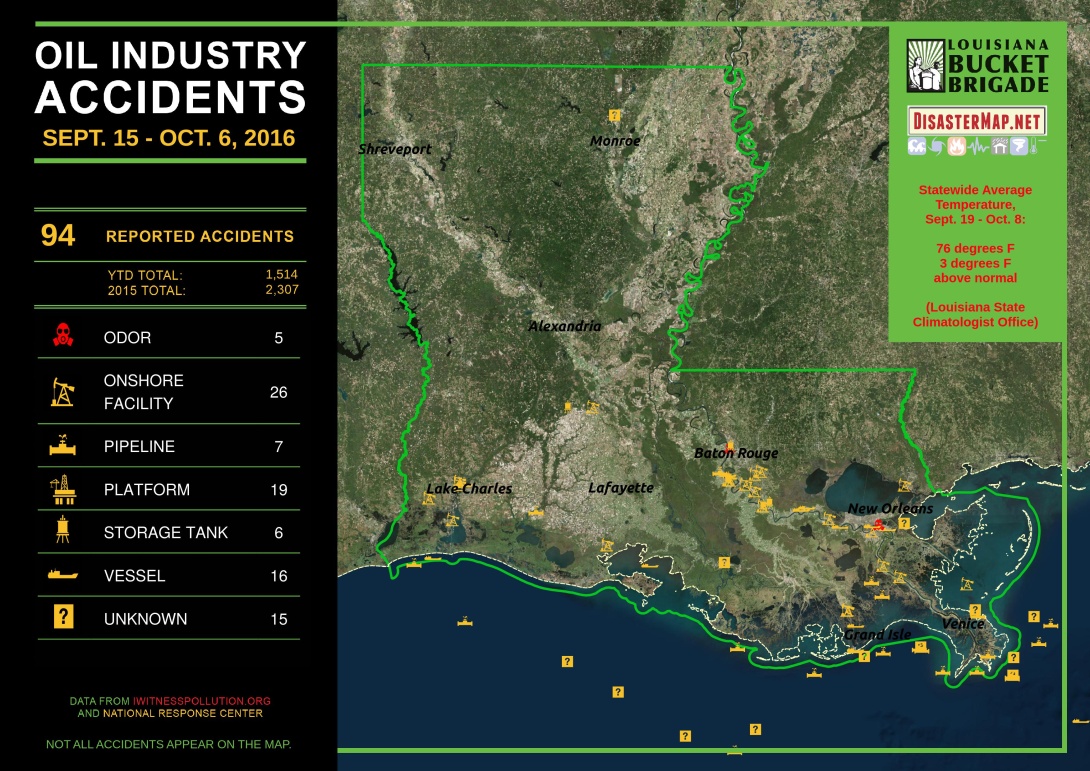The accident-prone oil industry is a chronic threat to the Gulf Coast's environmental health

(Map from the Louisiana Bucket Brigade's website.)
When we talk about the problem of oil industry accidents, we tend to focus on dramatic events like the deadly 2010 BP Deepwater Horizon explosion off the coast of Louisiana, or the 1989 Exxon Valdez oil tanker crash in Alaska's Prince William Sound. But the industry is far more accident-prone than such relatively rare high-profile disasters suggest.
This week an alliance of environmental groups released data they collected over a three-week period from Sept. 15 to Oct. 6 documenting oil industry accidents in Louisiana. They counted a total of 94 accidents — more than 30 a week. These included both land and offshore spills from pipelines, platforms, tanks, vessels and other facilities.
"We've known for a long time that the oil industry has an accident problem, but since many accidents are offshore and out of site, they get away with it," said Anne Rolfes, founding director of the Louisiana Bucket Brigade, a pollution watchdog group that worked with 350 Louisiana, DisasterMap.net and Vanishing Earth to compile and release the data. "This sampling … shows that the industry has a problem."
The analysis was based on numbers from the Coast Guard's National Response Center, the federal point of contact for reporting all oil spills and other pollution discharges into the environment. The oil industry is required by law to report its accidents, and the public can also contact the agency if they witness spills.
So far this year in Louisiana, 1,514 spills have been reported. That compares to 2,307 in all of 2015.
"Every time we fly out over the Gulf, we find something that needs to be reported to the National Response Center," said Jonathan Henderson, founding president of Vanishing Earth, a Louisiana-based organization that uses aerial photography to monitor the Gulf's environment. "The public deserves to know just how much contamination of our precious natural resources is occurring everyday."
"The public deserves to know just how much contamination of our precious natural resources is occurring everyday."
Besides threatening the environment, the industry's accident problem also puts workers at risk. While the new analysis doesn't address whether workers were injured in the recent accidents, U.S. offshore oil industry workers are seven times more likely to be killed on the job than U.S. workers overall, with an average fatality rate of 3.7 per 100,000 workers compared to 25.1 for offshore oil and gas workers, according to a Centers for Disease Control and Prevention study. The Louisiana Bucket Brigade has previously teamed up with labor groups to draw attention to the industry's workplace injury problem.
The environmental groups released their accident analysis at an Oct. 12 press conference in New Orleans at Shell's headquarters, a site chosen because the oil giant is the lead operator of the Gulf's deepest rig. Shell's $3 billion Perdido platform operates in nearly 8,000 feet of water on the outer edge of the U.S. Gulf between Louisiana and Texas, where oil companies have turned their attention in recent years. The difficulty of responding to serious accidents involving these extreme deepwater operations was shown by the BP disaster, which occurred in 5,100-foot waters.
The environmental groups behind the accident analysis are part of the burgeoning Keep It in the Ground campaign that's calling on the Obama administration to block new drilling leases in the Gulf and elsewhere in order to stave off the most devastating effects of climate change. They point out that during the three weeks they collected the data, the average temperature across Louisiana was 5 degrees F. above normal.
Along with the findings of their analysis, the groups released a map pinpointing locations of many of the reported accidents. It shows numerous pipeline spills along the coast as well as a cluster of accidents at facilities along the Mississippi River between New Orleans and Baton Rouge where the state's petrochemical industry is concentrated — a corridor dubbed "Cancer Alley" because of high rates of the disease.
They used an updated version of the Louisiana map that shows the eroded condition of the state's coastline. A serious concern for the low-lying state, land loss is tied to the oil and gas industry's activities in coastal wetlands — the digging of canals that allow saltwater intrusion and oil spills, both of which kill land-preserving vegetation. It's further exacerbated by sea-level rise due to climbing temperatures from heat-trapping pollution released by burning fossil fuels.
The environmental groups used the occasion of the data release to renew the call for President Obama to block new drilling leases.
"We have less than 10 years left to radically shift our business model and drop our greenhouse gas emissions," said Renate Heurich, an activist with 350 Louisiana. "At this point in history, it is insane to search for more oil and gas."
Tags
Sue Sturgis
Sue is the former editorial director of Facing South and the Institute for Southern Studies.
